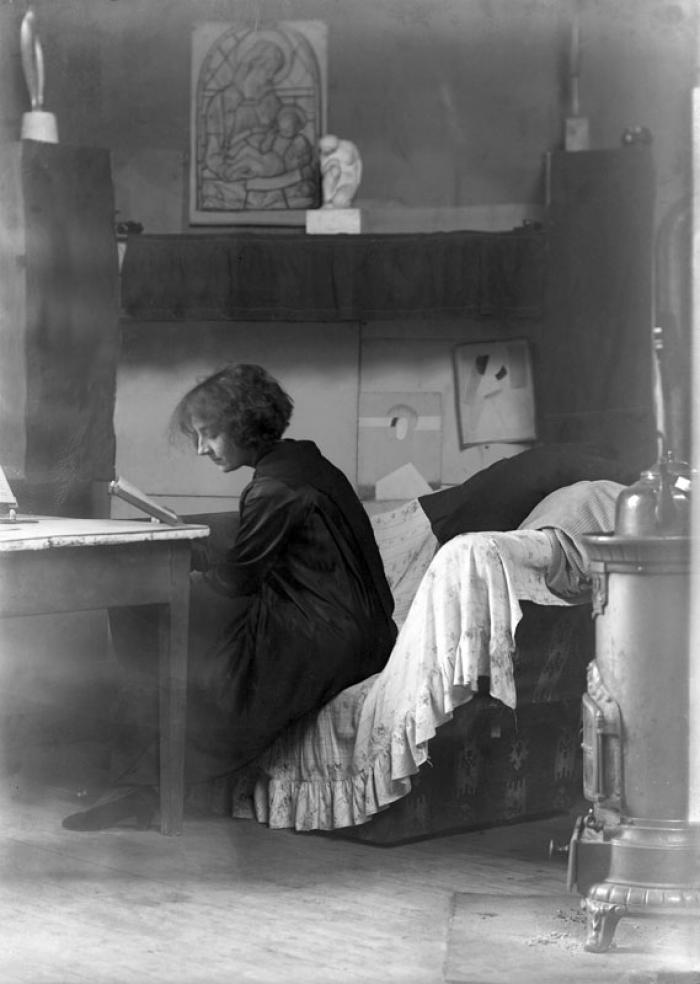MARTHE DONAS or TOUR DONAS
Antwerp 1885 - Audregnies 1967
A belgian woman artist in the european avant-garde
The avant-garde group "La Section d'Or" exhibiting at Galerie La Boétie in Paris, 1920. Among the participants, featuring world famous artists as Kupka, Léger, Braque, Archipenko and Brancusi, were three women painters : Natalya Gontcharowa, Irène Lagut and Marthe Tour-Donas.
|
Constructivist Composition or Yellow Circle 1917,
Oil on canvas, 55 x 35 cm, painted in the atelier of André Lhote, Paris, february 1917. SOLD This “Yellow Circle” is a strictly geometric composition painted in the spirit of the Russian constructivists. Cubism was not the crucial source of inspiration of Donas. Although she made a few cubist drawings and paintings in Paris, she was most of all influenced by Archipenko and his avant-garde compositions and sculptures. In 1917, she even worked in his studio in Nice and, through him, was introduced into the avant-garde circles in Europe. This work is probably also influenced by Kazimir Malevich, who at that time opted for a reductive, abstract style of Suprematism as an alternative to earlier art forms. In the Yellow Circle, the non-objective forms bear no relation to external phenomena and are constituted by geometric elements, painted in unmodeled and vivid colours, contrasting against a grey background. Marthe in her studio previously occupied by Diego Rivera in Montparnasse, rue du Départ, 1919. She received there a visit from Piet Mondriaan whom she introduced to Archipenko.
|
Marthe Donas in her atelier in Montparnasse, 1920Marthe Donas was one of the very first women abstract painters, with Sonia Delaunay-Terk and a number of russian artists such as Natalya Gontcharowa. Born in Antwerp, Marthe studies at the local Academy. In 1916 she settles Paris where she rents a studio in Montparnasse. She discovers cubism in the workshop of cubist painter André Lhote early 1917 and meets the famous ukrainian sculptor Archipenko later that year in Nice. Living and working with him in a villa nearby Nice, she joins the group “La Section d’Or” and exhibits together with the other members a.o. Léger, Braque, Gleizes, Duchamp, Brancusi, Villon, Kupka and Archipenko. At the end of WWI she rented again a studio in Montaparnasse which would be taken over by Mondriaan. Her work draws the attention of Theo Van Doesburg, who was the driving force behind the dutch review “De Stijl”. He writes several articles about her work and even puts one of her abstract drawings on the cover of “De Stijl”, which played an important role in promoting avant-garde art throughout Europe. During a number of years Marthe signs her works as "Tour Donas", "T. Donas" or "Tour d'Onasky" in order to get more attention from art critics, some of whom thought she was a male artist.
In 1919-1920, her work was exhibited in the Librairie Kundig in Geneva and in 1920, Herwarth Walden invited her to exhibit in his famous gallery “Der Sturm” in Berlin and bought all her paintings. Five of these were acquired by Katherine Dreier - daughter of a wealthy German immigrant living in the U.S.A. - who created the unique collection “Société Anonyme”, hereby assisted by her advisers Marcel Duchamp and Man Ray. In 1950, part of her collection was donated to the Yale University Art Gallery in New Haven, Connecticut. In the museum’s catalogue, Dreier even called Marthe Donas “the first woman abstract painter”. This famous collection was exhibited in several American museums in 2008-2009. In 2015 Donas was well represented in the exhibition "Sturm-Frauen : Women Artists of the Avant-Garde in Berlin 1910-1932" in Frankfurt-am-Main and in 2016 the Museum of Fine Arts in Ghent organized a major retrospective of her work. View of the Donas exhibition at Gallery "Der Sturm" in Berlin, 1920
|
Opening of the exhibition "Belgian women artists" at Group 2 Gallery featuring several works by Donas, 1995
Invitation of the exhibition "Tribal & Modern Art" at our avenue Louise headquarters, 1995








